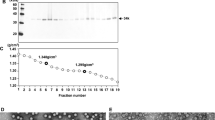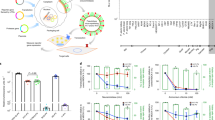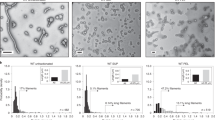Abstract
THE H-viruses are a new group of small agents, 180–250 Å in diameter, distinguished by their ability to produce a ‘mongoloid-type’ deformity in new-born hamsters1,2 and, in the case of H-1 to cross the placenta and cause malformation of the hamster embryo3–5. These viruses have been isolated from two host sources, man and rat. Two members of the group, H-1 and H-3, which differ from one another serologically, were first isolated from human tumours transplanted in conditioned animals; afterwards they, as well as HT and HB, were obtained directly from human embryos, placentas, and neoplasms6. Recently it was demonstrated that two human subjects injected with H-1 virus developed haemagglutination-inhibiting (HA-I) and neutralizing antibodies to H-1 (ref. 7). This indication that man is susceptible to infection by H-1 virus is supported by the observation that HA-I and neutralizing antibodies to H-1 virus have been found in the sera of several cancer patients, laboratory personnel, and pregnant women6,8. It has also been learned that rhesus monkeys are susceptible to infection with H-1 (ref. 9).
This is a preview of subscription content, access via your institution
Access options
Subscribe to this journal
Receive 51 print issues and online access
$199.00 per year
only $3.90 per issue
Buy this article
- Purchase on Springer Link
- Instant access to full article PDF
Prices may be subject to local taxes which are calculated during checkout
Similar content being viewed by others
References
Toolan, H. W., Science, 131, 1446 (1960).
Toolan, H. W., Dalldorf, G., Barclay, M., Chandra, S., and Moore, A. E., Proc. Soc. Exp. Biol. and Med., 46, 1256 (1960).
Toolan, H. W., Fed. Proc., 19, 208 (1960).
Ferm, V. H., and Kilham, L., Science, 145, 510 (1964).
Ferm, V. H., and Kilham, L., J. Embryol. Exp. Morph., 13, 151 (1965).
Toolan, H. W., Proc. Amer. Assoc. Cancer Res., 5, 64 (1964).
Toolan, H. W., Saunders, E. L., Southam, M. C., Moore, A. E., and Levin, A. G., Proc. Soc. Exp. Biol. and Med., 119, 711 (1965).
Monif, G. R., Sever, J. L., and Cochran, W. D., J. Pediatrics, 67, 253 (1965).
Toolan, H. W., (unpublished results).
Kilham, L., Virology, 13, 141 (1961).
Payne, F. E., Beals, T. F., and Preston, R. E., Virology, 23, 109 (1964).
Moore, A. E., Virology, 18, 182 (1962).
Kilham, L., Virology, 7, 428 (1959).
Portella, O., Archiv. Virusforschung, 14, 19 (1963).
Bernhard, W., Kasten, F. H., and Chaney, C., C.R. Acad. Sci., Paris, 257, 1566 (1963).
Wilt, J. C., Miller, D., and Ruiter, J., Canad. J. Microbiol., 10, 169 (1964).
Dulbecco, R., Hartwell, L. H., and Vogt, M., Proc. U.S. Nat. Acad. Sci., 53, 403 (1965).
Greene, E. L., Proc. Soc. Exp. Biol. and Med., 118, 973 (1965).
Author information
Authors and Affiliations
Rights and permissions
About this article
Cite this article
TOOLAN, H., LEDINKO, N. Growth and Cytopathogenicity of H-viruses in Human and Simian Cell Cultures. Nature 208, 812–813 (1965). https://doi.org/10.1038/208812a0
Issue Date:
DOI: https://doi.org/10.1038/208812a0
This article is cited by
-
Preliminary comparison of sensitivity toward parvovirus H-1 of human hepatoma cells and parahepatoma tissue
Chinese Journal of Cancer Research (1989)
-
Parvoviruses as contaminants of permanent human cell lines III. Biological properties of the isolated viruses
Archiv f�r die gesamte Virusforschung (1972)
-
Plaque Assay of the Effects of Cytosine Arabinoside and 5-lodo-2′-deoxyuridine on the Synthesis of H-1 Virus Particles
Nature (1967)
-
Susceptibility of the Rhesus Monkey (Macaca mulatta) to H-1 Virus
Nature (1966)
Comments
By submitting a comment you agree to abide by our Terms and Community Guidelines. If you find something abusive or that does not comply with our terms or guidelines please flag it as inappropriate.



